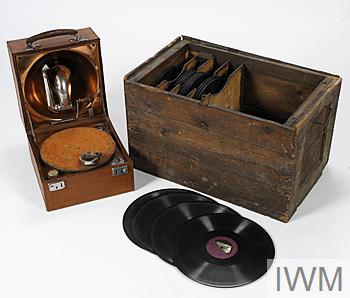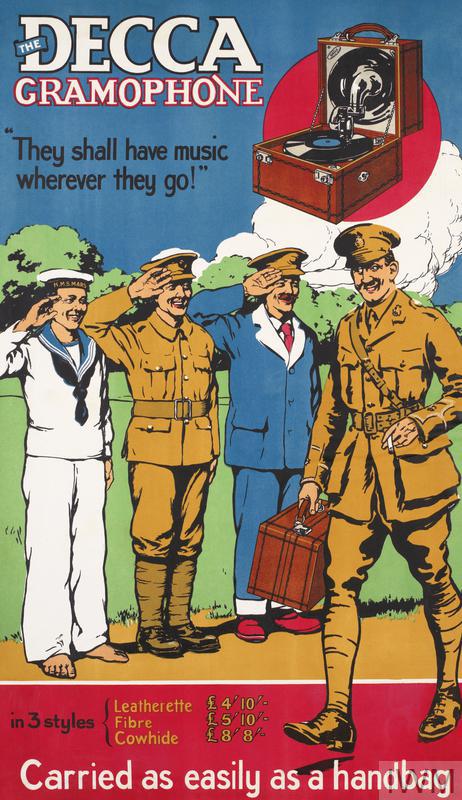RICHARD MADDOX
TODAY IT WOULD PROBABLY BE MUSIC STREAMED FROM A MOBILE (CELL) PHONE VIA WIRELESS BLUETOOTH HEADPHONES.
During the First World War it was the Decca ‘Trench’ Gramophone, a ‘portable’ music system – in this case packed into an old ammunition crate for ease of transport of the record player and the discs.

DECCA TRENCH GRAMOPHONE, a selection of the 32 records accompanying the gramophone and the converted ammunition box that housed both the records and the player. Image © IWM copyright, IWM catalogue reference EPH 7660. Original source https://www.iwm.org.uk/collections/item/object/30087341

AN ADVERTISING POSTER FOR THE DECCA GRAMOPHONE SHOWING AN OFFICER IN BRITISH UNIFORM carrying the gramophone and walking past a bare-foot sailor from ‘HMS Mars’ and two soldiers, one in khaki uniform. The other soldier wears ‘Hospital Blues’ – the uniform worn by soldiers in Military Hospitals and while convalescing. Artefact © IWM. IWM catalogue PST 13691. Original image source https://www.iwm.org.uk/collections/item/object/31665
According to IWM’s ‘Lives of the First World War’ website, Lieutenant Cyril Raymond Tobbitt was born at Wyefold Court (sic) in Oxfordshire, England in November 1891. (1)
This may be a geographic error. According to the 1871 Census his father did live at Wyford Court (where he was a Farm steward). Wyford Court – which has had a variety of uses including a psychiatric hospital – still stands. (2)
Albert and his wife Fanny moved to Neals Farm near Checkendon (about 2 miles or 3km from Wyford Court) in south Oxfordshire in 1873.
It was at Neals Farm where Florence – the first of his 13 children from three wives – was probably born. Fanny died the same year and there is a suggestion that she may have died in childbirth.
Albert became a widower on two occasions. Like Wyford Court Neals Farm is still in existence and is currently on a working farm.
Cyril was the last child to be born , his mother being Laura Mary Heard-Tobitt who Albert married after the death of his second wife in 1887. (3)(4)
He was commissioned as a Second Lieutenant in the King’s Royal Rifle Corps (KRRC) in 1915, before joining the Royal Engineers the year later where he served with No.62 Field Company.
The gramophone would accompany the Company in a variety of locations as the war progressed. These would include Ypres, Arras and Saint Quentin. (5) 6)
At THE END OF THE WAR NO. 62 FIELD COMPANY, RE WAS DISBANDED.
IT APPEARS THAT LOTS WERE DRAWN FOR PRIVATE ITEMS – THAT IS THOSE NOT ISSUED BY THE BRITISH ARMY.
CYRIL TOBITT BECAME THE PROUD OWNER OF THE GRAMOPHONE, SOMETHING THAT HAD PROVIDED ENTERTAINMENT AND LIFTED MORALE THROUGHOUT THE FINAL YEARS OF THE CONFLICT.
The Decca poster has some interesting information – both in the text and the accompanying visuals. As can be seen, the gramophone was available in three finishes the most expensive being almost twice the cost of the basic unit.
In 1914 an engine driver on the rail network would earn on average between 35 shillings and 50 shillings a week. Without accounting for inflation this translates as between £1.75p and £2.50p a week.
With the top of the line machine costing eight shillings and eight pence (twelve pence would equate to one shilling and twenty shillings would be one pound), this represents a relatively high proportion of a skilled working man’s weekly wage. (7)
The fact that the officer carries the record player could also indicate its relatively high price.
The illustration of the army officer shows a Lieutenant wearing his rank badge on his tunic sleeves. This method was first introduced in 1902. However in the trenches many officers removed these and wore their rank insignia on their shoulders, believing that this made them less of a target for enemy snipers.
After some resistance, this practice was accepted by the Army authorities with officer’s sleeve rank insignia being discontinued in 1920. (8)
The bare-foot sailor wears a cap tally showing he is serving on HMS Mars. This ship was built in 1894 and commissioned in 1897. When war broke out, the ship was serving as a guard ship on the Humber River in Yorkshire in the north of England before joining the Dover Patrol in December 1914.
In February 1915 Mars was converted to a troop ship and the ship’s main armament removed. The ship served in the Dardanelles area in 1916. (9)
The first of the two soldiers depicted wears a khaki uniform while the second depicts a wounded soldier either in a British Army hospital or military convalescent home. (10) (11)
Music and musical theatre – also called ‘music hall’ was very popular both in Britain and behind the lines in France. It was seen as good for morale, keeping soldiers in touch with things that were familiar to them.
A popular song of the time ‘Take me back to Dear Old Blighty‘ written in 1916 has as its theme a soldier thinking about ‘Dear Old Blightly’ – Britain – playing a song that reminds him of home on a gramophone. (12) (13)
Jack Dunn, son of a gun, somewhere in France today
Keeps fit doing his bit, up to his eyes in clay
Each night after a fight to pass the time along
He’s got a little gramophone that plays this song
NOTE
The Science Museum Blog has a very interesting story of another Decca Gramophone (on loan from IWM) written by photographer Judit Gyula. Entitled ‘The Gramophone that Soldiered On’ this can be found at:
https://blog.sciencemuseum.org.uk/the-gramophone-that-soldiered-on/
SOURCES
(1) https://livesofthefirstworldwar.org/lifestory/4460122 -retrieved 143 November 2018
(2) http://www.pjlivesey-group.co.uk/wyfold-court-henleys-lasting-legacy/ -retrieved 14 November 2018
(3) http://familystories.shancjackson.com/tobitt_Albert.html – retrieved 14 November 2018
(4) http://www.nealsfarm.com/ – retrieved 14 November 2018
(5) https://www.iwm.org.uk/collections/item/object/30087341 – retrieved 14 November 2018
(6) https://www.reubique.com/62fc.htm – retrieved 14 November 2018
(7) https://api.parliament.uk/historic-hansard/written-answers/1919/aug/01/wages-1914-and-1919 – retrieved 14 November 2018
(8) https://www.greatwarforum.org/topic/9660-please-help-british-wwi-sleeve-rank/ – retrieved 14 November 2018
(9) https://www.battleships-cruisers.co.uk/hms_mars.htm – retrieved 13 November 2018
(10) https://www.qaranc.co.uk/Army-Hospital-Blues-Uniform-WW1.php – retrieved 13 November 2018
(11) https://www.greatwarforum.org/topic/192140-blue-uniform-worn-by-hospital-patients-soldiers/ – retrieved 13 November 2018
(12) https://genius.com/Florrie-forde-take-me-back-to-dear-old-blighty-lyrics – retrieved 13 November 2018
(13) https://www.fredgodfreysongs.ca/Songs/Take_Me_Back_To_Dear_Old_Blighty.htm – retrieved 13 November 2018